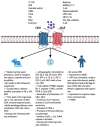A Comprehensive Exploration of the Multifaceted Neuroprotective Role of Cannabinoids in Alzheimer's Disease across a Decade of Research
- PMID: 39201317
- PMCID: PMC11354546
- DOI: 10.3390/ijms25168630
A Comprehensive Exploration of the Multifaceted Neuroprotective Role of Cannabinoids in Alzheimer's Disease across a Decade of Research
Abstract
Alzheimer's disease (AD), a progressive neurodegenerative disorder, manifests through dysregulation of brain function and subsequent loss of bodily control, attributed to β-amyloid plaque deposition and TAU protein hyperphosphorylation and aggregation, leading to neuronal death. Concurrently, similar cannabinoids to the ones derived from Cannabis sativa are present in the endocannabinoid system, acting through receptors CB1R and CB2R and other related receptors such as Trpv-1 and GPR-55, and are being extensively investigated for AD therapy. Given the limited efficacy and adverse effects of current available treatments, alternative approaches are crucial. Therefore, this review aims to identify effective natural and synthetic cannabinoids and elucidate their beneficial actions for AD treatment. PubMed and Scopus databases were queried (2014-2024) using keywords such as "Alzheimer's disease" and "cannabinoids". The majority of natural (Δ9-THC, CBD, AEA, etc.) and synthetic (JWH-133, WIN55,212-2, CP55-940, etc.) cannabinoids included showed promise in improving memory, cognition, and behavioral symptoms, potentially via pathways involving antioxidant effects of selective CB1R agonists (such as the BDNF/TrkB/Akt pathway) and immunomodulatory effects of selective CB2R agonists (TLR4/NF-κB p65 pathway). Combining anticholinesterase properties with a cannabinoid moiety may enhance therapeutic responses, addressing cholinergic deficits of AD brains. Thus, the positive outcomes of the vast majority of studies discussed support further advancing cannabinoids in clinical trials for AD treatment.
Keywords: Alzheimer’s disease; CB1R; CB2R; Cannabis sativa; GPR-55; Trpv-1; cannabinoids.
Conflict of interest statement
The authors declare no conflicts of interest.
Figures



Similar articles
-
Prevention of Alzheimer's disease pathology by cannabinoids: neuroprotection mediated by blockade of microglial activation.J Neurosci. 2005 Feb 23;25(8):1904-13. doi: 10.1523/JNEUROSCI.4540-04.2005. J Neurosci. 2005. PMID: 15728830 Free PMC article.
-
Cannabinoids in pain management: CB1, CB2 and non-classic receptor ligands.Expert Opin Investig Drugs. 2014 Aug;23(8):1123-40. doi: 10.1517/13543784.2014.918603. Epub 2014 May 16. Expert Opin Investig Drugs. 2014. PMID: 24836296 Review.
-
Decoding the Therapeutic Potential of Cannabis and Cannabinoids in Neurological Disorders.Curr Pharm Des. 2025;31(8):630-644. doi: 10.2174/0113816128318194240918113954. Curr Pharm Des. 2025. PMID: 39410886 Review.
-
Recent Advances in the Potential of Cannabinoids for Neuroprotection in Alzheimer's, Parkinson's, and Huntington's Diseases.Adv Exp Med Biol. 2021;1264:81-92. doi: 10.1007/978-3-030-57369-0_6. Adv Exp Med Biol. 2021. PMID: 33332005 Review.
-
In vitro and in vivo pharmacological activity of minor cannabinoids isolated from Cannabis sativa.Sci Rep. 2020 Nov 23;10(1):20405. doi: 10.1038/s41598-020-77175-y. Sci Rep. 2020. PMID: 33230154 Free PMC article.
Cited by
-
Exploring the diversity of cannabis cannabinoid and non-cannabinoid compounds and their roles in Alzheimer's disease: A review.IBRO Neurosci Rep. 2024 Dec 20;18:96-119. doi: 10.1016/j.ibneur.2024.12.011. eCollection 2025 Jun. IBRO Neurosci Rep. 2024. PMID: 39866750 Free PMC article. Review.
-
Bibliometric analysis of pathological mechanisms in Alzheimer's disease: Applications based on mouse models.J Alzheimers Dis Rep. 2025 Aug 13;9:25424823251367046. doi: 10.1177/25424823251367046. eCollection 2025 Jan-Dec. J Alzheimers Dis Rep. 2025. PMID: 40822130 Free PMC article. Review.
References
-
- American Psychiatric Association . Diagnostic and Statistical Manual of Mental Disorders: DSM-5. 5th ed. American Psychiatric Association; Washington, DC, USA: 2013.
-
- Dunne T.E. Encyclopedia of Mental Health. Elsevier; Amsterdam, The Netherlands: 2016. Alzheimer’s Disease: An Overview. - DOI
-
- Sperling R.A., Aisen P.S., Beckett L.A., Bennett D.A., Craft S., Fagan A.M., Iwatsubo T., Jack C.R., Jr., Kaye J., Montine T.J., et al. Toward defining the preclinical stages of Alzheimer’s disease: Recommendations from the National Institute on Aging-Alzheimer’s Association workgroups on diagnostic guidelines for Alzheimer’s disease. Alzheimers Dement. 2011;7:280–292. doi: 10.1016/j.jalz.2011.03.003. - DOI - PMC - PubMed
Publication types
MeSH terms
Substances
LinkOut - more resources
Full Text Sources
Medical

